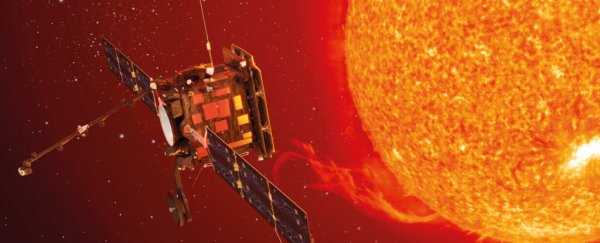Today is an exciting day in space news: We're about to launch a spacecraft that will give us unprecedented access to our Sun's shy sides.
When United Launch Alliance's Atlas V rocket takes off later today, the European Space Agency's (ESA) Solar Orbiter will be snuggled inside to help us study our star up close and personal.
Atlas V is set to blast off at 04:03 GMT (11 pm local time) from Launch Complex 41 at Cape Canaveral, and you can watch the whole thing below through the NASA broadcast.
 (ESA)
(ESA)
If all goes to plan, the Solar Orbiter will separate from Atlas V around 53 minutes after launch. It will then spend the next three-and-a-half years moving closer to the Sun, ending up in a highly elliptical orbit; at its closest, the orbiter should achieve a quarter of the distance between Earth and the Sun.
The spacecraft has been specially designed to survive temperatures of up to 500 degrees Celsius (932 degrees Fahrenheit), and withstand the high numbers of charged particles it's likely to be bombarded with while travelling so close to a star.
The entire thing is protected by a titanium shield; as its instruments set to work, the probe will be peeking at the Sun from behind this protective layer.
 (ESA)
(ESA)
The Solar Orbiter is not the only Sun-staring probe we have in our arsenal. Launched in 2018, NASA's Parker Solar Probe was built with the intention of eventually 'touching the Sun' – planned to reach as close as a blistering 6.2 million kilometres (2.83 million miles) from our home star. This is a lot closer than the Solar Orbiter's 41 million kilometres (26 million miles).
But although the Parker Probe might seem flashier, the Solar Orbiter still has some important science to take care of.
"Solar Orbiter is all about the connection between what happens on the Sun and what happens in space," Solar Orbiter magnetometer Principal Investigator Tim Horbury told the BBC.
"We need to go close to the Sun to look at a source region, then measure the particles and fields that come out from it. It's this combination, plus the unique orbit, that makes Solar Orbiter so powerful in studying how the Sun works and affects the Solar System."
One exciting part of the Solar Orbiter's mission is that it'll be moving outside of the relatively flat plane of the Solar System's planets, and will move into an orbit that gives us our first view of the Sun's poles.
The team hopes this will increase our understanding of solar storms - huge radiation bursts from the Sun that can wreak havoc on Earth's electronic equipment, and could lead to absolute technological chaos if we aren't prepared.
You can watch the launch at the link below:

We don't yet know what surprises the Solar Orbiter will reveal about our incredible host star, but we're looking forward to seeing what it can do.
